With spring coming around, swimming season will soon be upon us. Although beaches are a common getaway, many of us love swimming in pools. But, when the pool is murky, smelly, or dirty, well, the healthy swimming environment we were looking forward to definitely goes down the drain.
Before you resort to avoiding the swimming pool entirely, rest assured that you can restore its “shine” by cleaning it with chlorine. But how much should you add?
It can be difficult to figure out at first, but once you learn how to do it, you’ll never worry about adding chlorine again. We’re going to show you how to determine the amount of chlorine to add to your swimming pool.
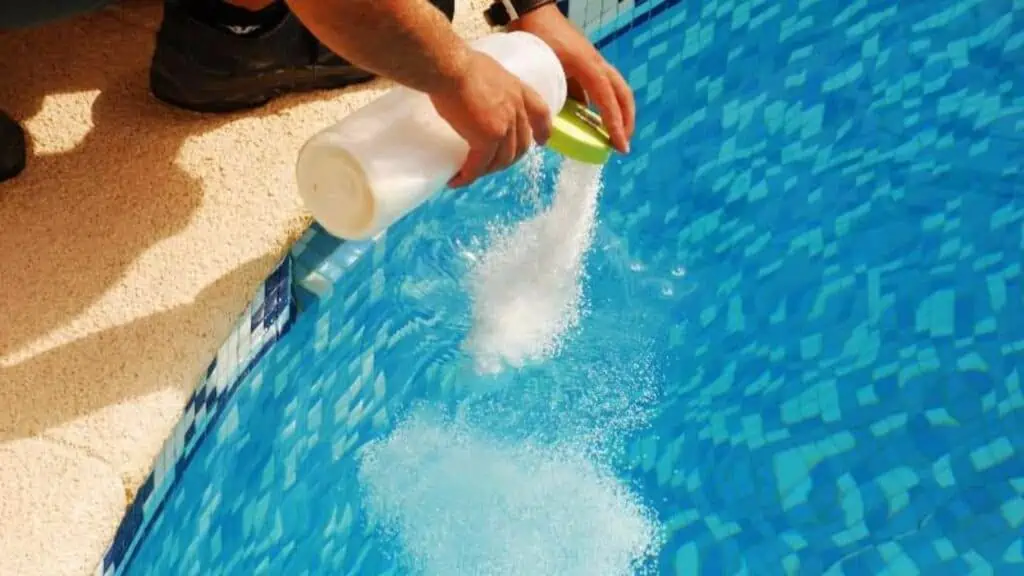

Determining how much chlorine to put in pool
You need to how much chlorine to add to the pool per gallon to make sure it’s properly sanitized and that it doesn’t cause adverse reactions to swimmers. Remember, there is such a thing as too much chlorine!
Getting that balance right relies on two things: knowing the volume of the pool and testing the water. So you must know these before you can work out the amount of chlorine to add to your pool.
You will find how to calculate the volume of the pool in gallons and how to test the pool water further down the page if you are unsure.
How much chlorine to add to pool?
Once you’ve tested the chlorine levels and determined the pool’s volume, you can then calculate how much chlorine to add to the pool water using the following how much chlorine to add to pool calculator tables.
Chlorine powder or granules
Use the following table to determine how much powdered or granulated chlorine to add to pool water.
How Much Chlorine to Add to Pool Calculator
Use this table to determine how many ounces (oz.) or pounds (lbs.) of chlorine to add based on your pool’s volume (in gallons) and the desired parts per million (ppm).
| Volume (Gallons) | 1 ppm | 2 ppm | 3 ppm | 4 ppm | 5 ppm |
|---|---|---|---|---|---|
| 5,000 | 1.11 oz. | 2.22 oz. | 3.33 oz. | 4.44 oz. | 5.55 oz. |
| 10,000 | 2.22 oz. | 4.44 oz. | 6.66 oz. | 8.88 oz. | 11.1 oz. |
| 15,000 | 3.33 oz. | 6.66 oz. | 9.99 oz. | 13.32 oz. | 1.04 lbs. |
| 20,000 | 4.44 oz. | 8.88 oz. | 13.32 oz. | 1.11 lb. | 1.39 lbs. |
| 25,000 | 5.55 oz. | 11.1 oz. | 1.04 lbs. | 1.39 lbs. | 1.73 lbs. |
| 30,000 | 6.66 oz. | 13.32 oz. | 1.25 lbs. | 1.67 lbs. | 2.08 lbs. |
| 35,000 | 7.77 oz. | 15.54 oz. | 1.46 lbs. | 1.94 lbs. | 2.43 lbs. |
| 40,000 | 8.88 oz. | 1.11 lbs. | 1.67 lbs. | 2.22 lbs. | 2.67 lbs. |
So if you had a 25,000 gallon pool and the current chlorine reading is 1ppm and you wanted to raise it to 3ppm, you would need to add 11.1 ounces of chlorine (as you would be increasing it by 2ppm).
Liquid Chlorine
Use the following table to determine how much liquid chlorine to add to pool water.
If you’re using liquid chlorine, then you need to read the label to calculate how much liquid chlorine to add as the chlorine levels vary depending on the brand.
How Much Liquid Chlorine to Add
Consult this table to determine how many pints of liquid chlorine are needed to raise your pool water to the desired parts per million (ppm) based on your pool’s volume.
| Volume (Gallons) | 1 ppm | 2 ppm | 3 ppm | 4 ppm | 5 ppm |
|---|---|---|---|---|---|
| 5,000 | 0.25 pints | 0.5 pints | 1 pint | 1.34 pints | 1.67 pints |
| 10,000 | 0.5 pint | 1 pint | 2 pints | 2.67 pints | 3.3 pints |
| 15,000 | 1 pint | 2 pints | 3 pints | 4 pints | 5 pints |
| 20,000 | 1.33 pints | 2.66 pints | 4 pints | 5.33 pints | 6.66 pints |
| 25,000 | 1.66 pints | 3.33 pints | 5 pints | 6.66 pints | 8.33 pints |
| 30,000 | 2 pints | 4 pints | 6 pints | 8 pints | 10 pints |
| 35,000 | 2.33 pints | 4.66 pints | 7 pints | 9.33 pints | 12 pints |
| 40,000 | 2.66 pints | 5.33 pints | 8 pints | 10.66 pints | 14 pints |
So if you had a 25,000 gallon pool and the current chlorine reading is 1ppm and you wanted to raise it to 3ppm, you would need to add 3.33 pints of liquid chlorine (as you would be increasing it by 2ppm).
How to add chlorine to pool
When using powdered chlorine or chlorine granules you should first mix them in a bucket of pool water. For safety’s sake, always add the water first, then add the chlorine to the water. Then mix it until it is completely dissolved. If you add quite a substantial amount you will need to mix it in stages using a number of buckets of water.
Both for the chlorine you have mixed in a bucket and liquid chlorine, walk around the pool’s edge pouring the mixed chlorine into the pool as you go.
You should run the pool pump and pool filter for a few hours at least after adding the chlorine to ensure it is spread evenly.
If using chlorine tablets then you can put them in a floating chlorine dispenser which will allow water in and dispense chlorine to your pool slowly as it floats. You can also put chlorine tablets in your skimmer basket – see Can you put chlorine tablets in a skimmer basket?
Calculating the volume of a swimming pool
If you already know the volume of your pool, obviously you can skip this section. Or you can use the handy volume calculator at the end of this section
Knowing how many gallons your pool holds, whether it is an in-ground pool or an above ground pool. is something that you will need to know quite often when maintaining your pool, not just when you want to chlorine to the pool.
When calculating the volume of your pool (pool size), you are going to need all or some of these values:
- Area (A)
- Width (W)
- Depth (D)
- Height (H)
- Length (L)
- Volume (V)
- Diameter (d)
- Radius (r)
- Pi (3.14)
When calculating the cubic volume of your swimming pool, you will need to know the depth and surface area. To get the most accurate calculations, you may need to separate your pool into sections based on depth. This means you calculate the shallow end separately from the deeper end.
One cubic foot of water consists of 7.5 gallons of water. So after you’ve determined the cubic footage of the swimming pool, the next step is to multiply that number by 7.5. The result of this calculation is the volume of your pool in gallons (how much water it can hold).
Since pools can be of different shapes, calculating the volume will be based on your pool’s geometry. Most pools are rectangular or squared, so we’ll start there. For any shaped swimming pool, though, you must first determine if the depth is the same throughout.
Rectangular pool (or square)
If the depth is consistent, then you need to measure the length and width of your pool. Multiply this figure by the depth to get the cubic feet. After that, you should multiply the result by 7.5 to get the pool’s volume in gallons.
This is the formula you should be working with: V = L x W x D x 7.5
If the bottom of your pool has a gradual slope, then you need to use the average depth of the pool to determine its volume. You can get this measurement by adding the depth of the shallow end to the depth of the deep end and then dividing that by two. The length, width, and depth of the surface area of the pool should be added together.
For pools that have variable depths and drop-offs, you need to treat the shallow ends and deep ends as separate pools. So you would need to calculate the volume for both individually and then add the numbers together to get the cubic volume for the entire pool. Multiply that by 7.5 to get the volume in gallons.
Round swimming pool
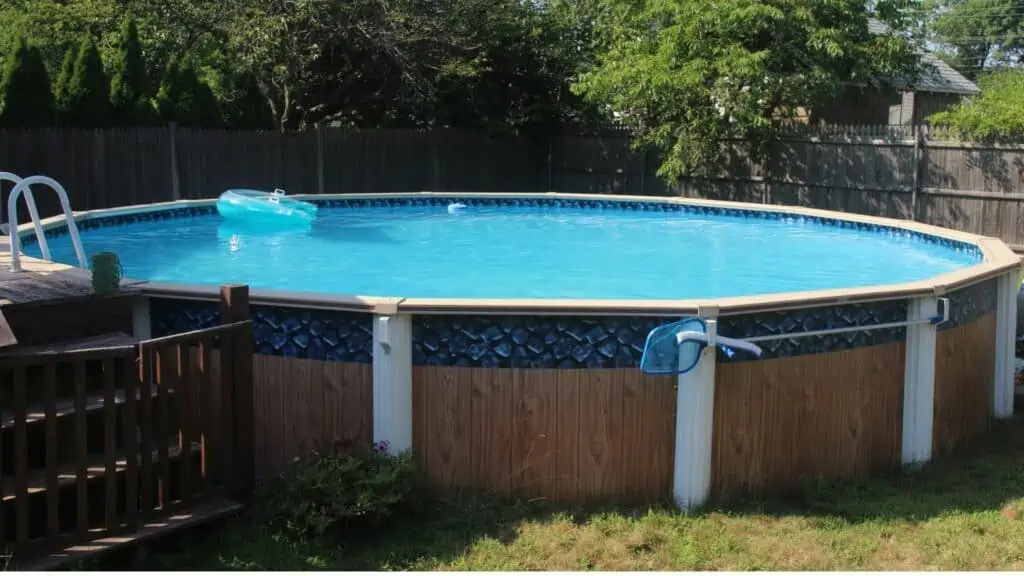
To get the volume of a round pool, you would multiply the radius squared (r2) by Pi (3.14), then by the diameter. You can find the diameter by measuring the length or width of the pool (should be the same distance since it’s round). You would divide the diameter by two to get the radius.
To get the radius squared, just multiply it by itself once. The complete formula for the volume in gallons should look like this: V = 3.14 x r2 x d x 7.5
It will take some complex calculations to get everything right. If the calculations become overwhelming, you can try to use an online calculator to see if that works for you.
Pool Volume Calculator
Please enter your pool shape and dimensions:
Irregular swimming pools
Not all pools can fit into a single, plane shape. But they can be broken down into several simple shapes, and that’s the best way to measure these complex pools.
You would need to identify the different round, square, and rectangular sections in the pool. Then you would calculate the volume based on the shape of each section. Once you have all the numbers, you would just add them up for the final result.
Testing your pool’s chlorine level
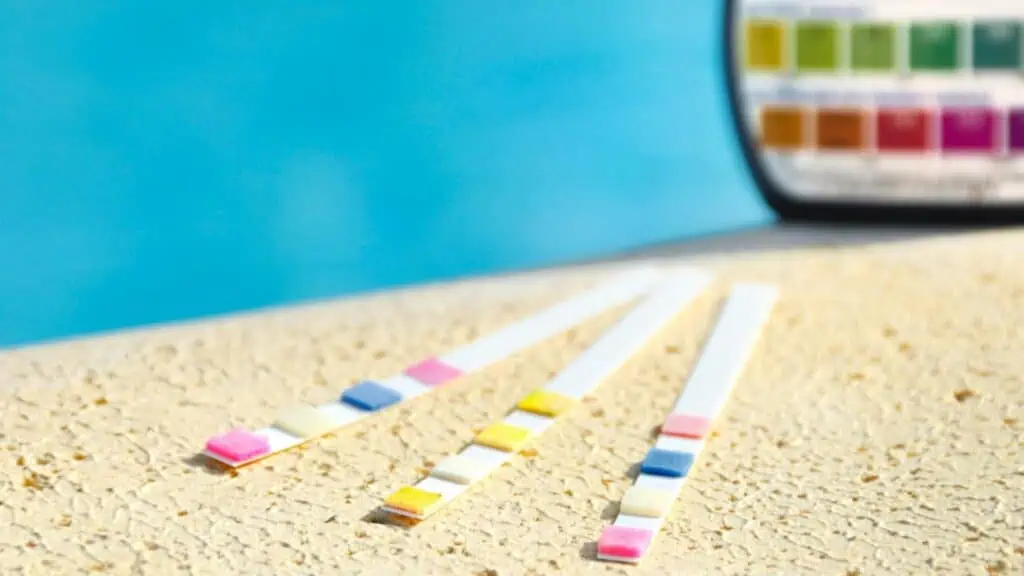
Now that you have the volume for your swimming pool, we can move on to the next step. Before you add any chlorine, you need to know how much is already in the pool water. Again, we don’t want too much chlorine in there, right?
Ideally, you want the concentration of chlorine to be between 1 ppm (parts per million) and 3 ppm. 2-3 ppm is considered a neutral level.
When testing how much chlorine is in your pool water, you must be aware of the different types. The three types of chlorine that are important are free chlorine, combined chlorine and total chlorine.
Combined chlorine is chlorine that has already sanitized and has combined with contaminants in the water. Free chlorine has yet to bind with any contaminants so it is available to sanitize. See my post Free chlorine vs total chlorine vs combined chlorine for more details.
There are test kits that give you the value of free chlorine and total chlorine (sum of combined and free available chlorine) present in the water. These are usually more expensive.
Here are the different ways or equipment that can be used to test the chlorine concentration in the water:
- Chlorine test strips
- Chlorine test kits
- Electronic chlorine testers
- Automatic chlorinator and tester
If you’ve recently added chlorine, you should wait 24 hours before testing. Most test strips and kits are easy to use, so just follow the instructions that come with them.
Chlorine test strips
Test strips are probably the simplest way to test the water in terms of the technology used. They are short paper strips with reactive areas and the container has color charts on the outside.
You dip the test strip into the pool for 5-10 seconds and then compare the colors with the chart to give readings for various levels such as pH, total alkalinity, chlorine etc.
Recommended Test Strips
Chlorine test kits
These are more complex than test strips but are also more accurate and reliable. By sampling a large amount of water from your swimming pool, test kits can provide a more accurate measurement of how much chlorine is in the water.
Included in each kit is:
- A guide/manual
- Test tube to hold samples
- Reagents
- Saturation index tool
It is important that you follow the instructions exactly as directed or you won’t get accurate results. Test kits also come with color graphs to help decipher the chlorine levels.
Recommended Test Kit
Electronic digital chlorine testers
For those who are color blind or have trouble with the color charts, electronic testers are a good alternative. It’s a bit faster and simpler than the previous methods, but it needs to be calibrated before use. As a handheld device, you would use it to sample the water and then wait for the results as it measures the exact chlorine levels.
There are some testers on the market that can run continuously. You can also get a tester that can provide data on other things as well.
Recommended Digital Tester
Liquid chlorine, chlorine tablets, or chlorine granules?

Now that you know how to calculate how much chlorine to put in your pool, and have figured out different ways to determine the chlorine level of your swimming pool, the next question becomes which form of chlorine should you use. As a pool owner, that really depends on your personal preference.
For example, chlorine tablets and granules are much lighter to carry around than hauling the equivalent amount of liquid chlorine back and forth. And with a floating chlorine dispenser, or adding the chlorine tablets to your pool skimmer, you do get a sort of uniformity to your chlorine level.
Not to mention, chlorine tablets dissolve slowly, more so than chlorine granules, and so keep the chlorine level in your swimming pool constant. Determining how many tablets you need, though, is tricky.
However, liquid chlorine really doesn’t involve a lot more work than pouring the liquid in. Since liquid chlorine is relatively weak you might be surprised at how much you actually need.
Handling chlorine safely
Before you put anything into your pool, you need to first understand the nature of this chemical and how it affects what it comes into contact with.
Chlorine is the most popular pool sanitizer and is great for keeping your pool safe and clean because it can kill germs and prevent outbreaks. However, the chemical itself is very corrosive.
This means you need to handle it with care and follow proper procedures when using it.
Tips to follow
- Always inspect the label and instructions that come with your pool cleaning products.
- When it comes to protecting yourself, use personal protective equipment (PPE) whenever you’re handling chemicals. The most common injuries that occur when handling chlorine are inflammation of the eyes, face, hands, and lungs. To prevent these injuries you should use chemical-resistant gloves, goggles, and only open chemical containers in wide, open spaces.
- Opening chemical containers indoors (especially in small, enclosed spaces) will enable the chemical to concentrate in the air. This increases the likelihood of lung injury. When you open the containers outside, the chemicals can safely disperse into the fresh air and tend to waft away from you.
Working out how much chlorine to add to your pool can seem daunting. It could be one of the harder things to figure out since it involves so many calculations.
However, once you’ve determined the size of your pool and the current chlorine levels, things get easier, and you’ll be able to enjoy the swimming season a whole lot more!
FAQs
How do I calculate how much chlorine to add to my pool?
The amount of chlorine you need to add to your pool depends on the size of your pool and the current chlorine levels. You can use a pool calculator to determine the amount of chlorine required based on these factors.
Can I add too much chlorine to my pool?
Adding too much chlorine to your pool can be harmful to swimmers and can damage the pool’s surface and equipment. It’s important to follow the recommended guidelines for adding chlorine to your pool.
How often should I add chlorine to my pool?
It’s recommended to add chlorine to your pool daily, or at least every other day, to maintain proper sanitation levels. The amount of chlorine needed may vary depending on pool usage, weather, and other factors.
Can I use different types of chlorine in my pool?
There are different types of chlorine available, including granular chlorine, liquid chlorine, and chlorine tablets. Each type has its own unique benefits and considerations, so it’s important to choose the right type for your pool and follow the manufacturer’s instructions.
Do I need to shock my pool with chlorine?
Shocking your pool with chlorine is recommended periodically to help eliminate bacteria and algae growth. The frequency of shocking depends on pool usage, weather, and other factors. It’s important to follow the recommended guidelines for shocking your pool and use a shock treatment specifically designed for pools.





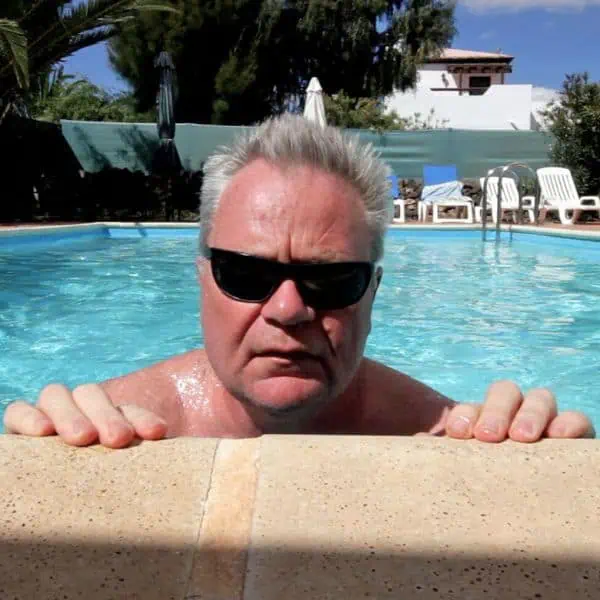


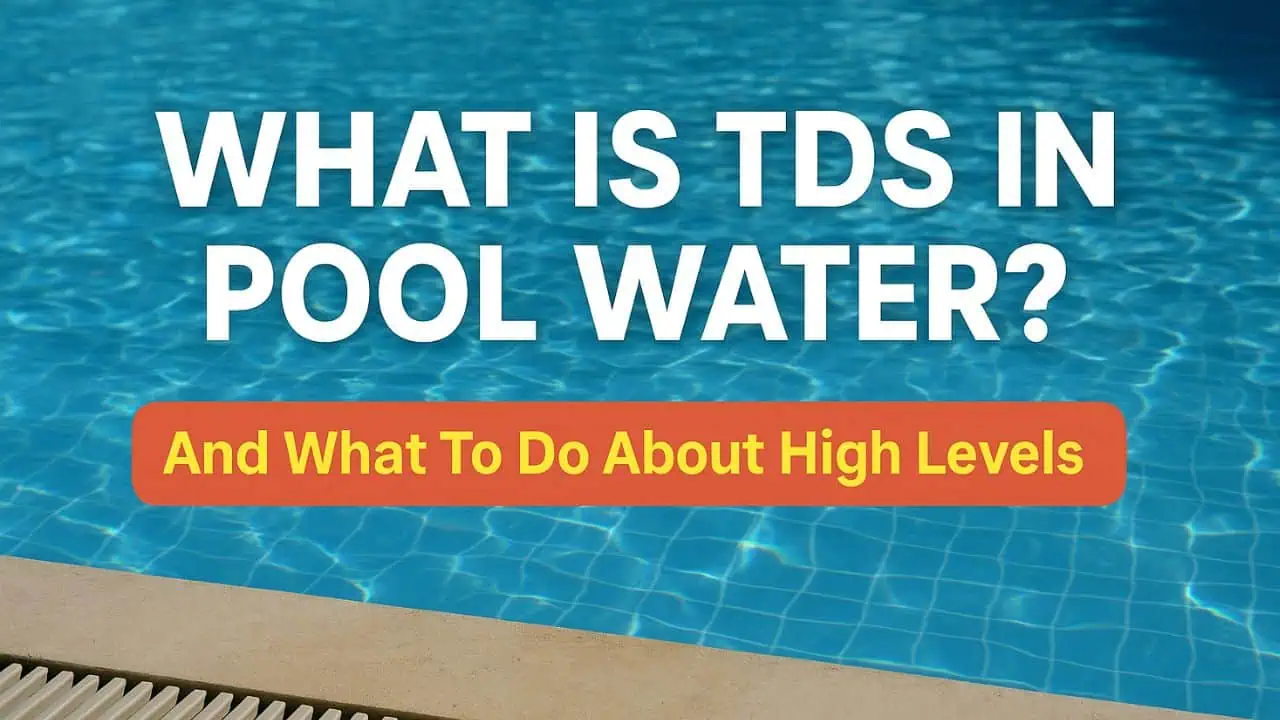
Leave a Reply